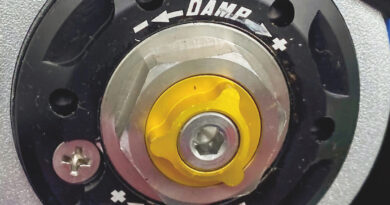Antigravity ATX-12 RS battery
Stranded in the middle of nowhere. That was my initial assessment when the starter button produced nothing but silence. On a disaster-riddled off-road ride described elsewhere (see Too Much Adventure; [article location]), I’d dismounted at a trail’s dead end to scout for possible ways forward. I hadn’t expected to be off the bike for long, and I wasn’t in the best frame of mind. These factors converged in my failure to turn off the bike’s key, leaving an electron-hungry aftermarket lighting system unhindered access to the feedbag that was my battery. While I gave lengthy consideration to a complicated and treacherous water crossing that might allow passage to another trail nearby, said lighting system feasted until there was nothing left to consume. I was already primed to encounter catastrophe, and my immediate interpretation of the situation took shape accordingly.
 After a few minutes reviewing bleak and dreadful options, I burst into laughter. I remembered the ReStart button – a clever feature Antigravity has included on some of their lithium-ion (technically LiFePO) batteries for the last couple of years. These batteries come equipped with a special circuit that detects when their voltage drops to a dangerously low level and cuts off the juice while there’s still enough left to start the motor, preserving the capacity for several attempts. The ReStart button restores battery functionality; think of it as a reserve petcock for your power source. Installation of this battery was the reason I’d stopped carrying a pocket jump-starter in my backpack, but that decision had been made months ago and forgotten amidst my initial crisis reaction.
After a few minutes reviewing bleak and dreadful options, I burst into laughter. I remembered the ReStart button – a clever feature Antigravity has included on some of their lithium-ion (technically LiFePO) batteries for the last couple of years. These batteries come equipped with a special circuit that detects when their voltage drops to a dangerously low level and cuts off the juice while there’s still enough left to start the motor, preserving the capacity for several attempts. The ReStart button restores battery functionality; think of it as a reserve petcock for your power source. Installation of this battery was the reason I’d stopped carrying a pocket jump-starter in my backpack, but that decision had been made months ago and forgotten amidst my initial crisis reaction.
I’ve put these batteries in a half-dozen other bikes, but I’d never had to find out how well the ReStart technology actually works. With breath held and fingers crossed, I pressed the button on top of the battery. As soon as I turned the key back on, the fuel pump’s whirring sounded promising. The next stab at the starter brought the motor to life instantly. WHEW!! At least one catastrophe was averted that day. Thanks, Antigravity!
I’ve come to value the power, reliability, and convenience of Antigravity batteries over the years. Even without the ReStart circuit, lithium-ion batteries often offer significant advantages over the OEM units they replace, albeit at a higher price-point. These include increased power, smaller size, lighter weight, and longer (up to a year) shelf life, because they don’t self-discharge without parasitic drain. My most recent acquisition was the ATX-12 RS, purchased for $224.99 to replace the dying AGM battery in my F 800 GT (not the bike in the off-road story above!). Whereas the old battery cost about a third of the new ones price, it weighed 10lbs., 2oz.; the new one is a mere 2lbs., 5oz. Cold cranking amps were rated as 200 (old) and 360 (new), with both carrying amp-hour ratings of 12. (Note that lithium-ion battery amp-hours must be converted to a lead-acid equivalent for fair comparison; the ATX-12’s unconverted rating is 6.1 AH.)
 Some Antigravity batteries are substantially smaller than their conventional counterparts. These arrive with stiff foam panels that can be used to fill up the leftover space, if necessary for proper fitment in the allotted space. While my ATX-12 had about the same exterior dimensions as the battery it replaced, the F 800 GT’s battery bracket was designed for a more typical set of indentations in the battery’s top. With very little improvising (slipping a thin sheet of rubber behind the battery), everything buttoned up neatly and securely. Accessing the ReStart button in this application requires removal of eight bodywork fasteners, as well as the bracket, which happens to pass right over the button. Still, this labor would be preferable to getting the bike towed or leaving it in search of a replacement battery! There may still be reasons to carry a power-pack jump-starter, but ReStart makes the weight, bulk, and expense of one optional. As shown, the ATX-12 RS also features four terminals, allowing easier fitment where the usual connections are reversed or additional connections for accessories are desirable.
Some Antigravity batteries are substantially smaller than their conventional counterparts. These arrive with stiff foam panels that can be used to fill up the leftover space, if necessary for proper fitment in the allotted space. While my ATX-12 had about the same exterior dimensions as the battery it replaced, the F 800 GT’s battery bracket was designed for a more typical set of indentations in the battery’s top. With very little improvising (slipping a thin sheet of rubber behind the battery), everything buttoned up neatly and securely. Accessing the ReStart button in this application requires removal of eight bodywork fasteners, as well as the bracket, which happens to pass right over the button. Still, this labor would be preferable to getting the bike towed or leaving it in search of a replacement battery! There may still be reasons to carry a power-pack jump-starter, but ReStart makes the weight, bulk, and expense of one optional. As shown, the ATX-12 RS also features four terminals, allowing easier fitment where the usual connections are reversed or additional connections for accessories are desirable.
In addition to protecting users like me from their own forgetful negligence, the ReStart circuit will trip if too many accessories suck up wattage while the engine is running. The same principle applies since any drain in excess of the charging system’s capacity gets pulled from the battery. Remember, a battery does not otherwise contribute to a motorcycle’s operation and should simply be the passive recipient of replenishing charge after its work of spinning the starter/fuel pump is done. A battery put to sleep by the ReStart circuit in this case would cause lights and accessories to grow weak or stop working, signaling the rider to reduce the load on the electrical system.
A battery revived by the ReStart button obviously needs recharging. Such a revival should be followed by enough riding to accomplish this or refreshing the battery with an external charger. Lithium-ion batteries should be charged with purpose-built chargers, not those made for lead-acid batteries. That said, the Battery Management System built into Antigravity batteries protects against over-discharge, over-charge, and thermal excess, and automatically balances the cells. All of this presumably extends battery life and helps avoid damage to the battery and to nearby objects that would be affected by battery overheating. Antigravity batteries come in a wide variety of sizes and capacities, and are covered by a 3-year warranty.




On the right side of this page says “Don’t Miss These”
Each heading sends me to this link: https://themegrill.com/themes/accelerate/
Makes no sense to me. I was looking for more articles. Even the great Jack Riepe couldn’t break through!
Thanks for mentioning this – it’s a new site & we’re still working out some of the details.